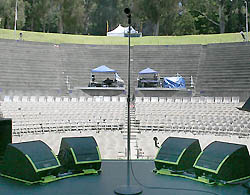
Processed Amplifiers
In our modern world of digital consoles, it’s common for monitor engineers to build output EQ libraries for specific models of wedges.
By eliminating variances between amp channels used for woofers and horns, both passive and self-powered floor monitors provide a level of consistency, allowing EQ presets created on one rig to work on another system in the next city or country.
Bi-amplified wedges that use specific or proprietary processed amplifiers, such as those from L-Acoustics, d&b audiotechnik and Nexo provide a similar level of consistency.
Modern amplifiers that incorporate DSP, such as more recent Crown, Lab.gruppen and Yamaha models, allow manufacturers and vendors with proprietary loudspeakers to achieve a similar level of consistency.
The definition of “pro audio” in the future includes tight integration of loudspeakers, amps and DSP that allows precise and predictable results in a wide range of applications.
One, Two, Three
Intuition invites the age-old rock wedge approach that two are better than one, but there’s a case where it doesn’t necessarily apply. Dual high-frequency sources firing at a microphone will cause comb filtering unless the mic is exactly equidistant from both.

A difference of an inch introduces a deep cancellation notch at 6,000 Hz, or at 3,000 Hz at two inches. Moving a vocal mic, or one of a pair of wedges a small distance can therefore change the HF gain-before-feedback. This comb-filtering scenario can be avoided by using a single wedge for vocals in a monitor mix.
On the other hand, presenting that performer’s instrument through double wedges gives it added presence, due to the arrival at both ears from dual sources. Stereo floor monitors allow for panning of other performer’s signals in perspective on stage, making them easier to discern.
When a performer needs the ultimate in monitoring – lots of their vocal and their instrument, plus everything else – a time-tested approach is to use three wedges on three mixes. The center wedge carries the vocal, while the outside stereo pair provides the performer’s instrument, along with any reverb in stereo and the rest of the band’s instruments and vocals panned in perspective.
